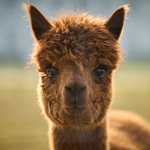National Alpaca Day in Peru Date in the current year: August 1, 2026
 On August 1, Peruvians celebrate National Alpaca Day (Dia Nacional del Alpaca). This holiday was created to honor cute, fuzzy animals that are often confused with llamas and to highlight their importance for the economy of Peru.
On August 1, Peruvians celebrate National Alpaca Day (Dia Nacional del Alpaca). This holiday was created to honor cute, fuzzy animals that are often confused with llamas and to highlight their importance for the economy of Peru.The alpaca is a South African mammal that belongs to the family Camelidae, which also includes camels, llamas, guanacos, and vicuñas. Alpacas are often confused with llamas because the two animals look very alike, but llamas are typically noticeably bigger than alpacas. Unlike llamas that are bred as working animals, as well as for their meat and fiber, alpacas are raised exclusively for their fiber.
Alpacas are native to the Andean regions of Peru, Bolivia, Ecuador, and Chile, and can be found throughout most of South America, as well as around the globe in captivity. They were domesticated thousands of years ago, and today, there are no known alpacas living in the wild.
There are two breeds of the alpaca based on their fibers: Huacaya and Suri. Huacaya alpacas constitute about 90% of the alpaca population, and Suri alpacas represent around 10%. Huacaya fiber looks similar to sheep’s wool, whereas Suri fiber looks more like silk.
Alpaca fleece is considered a valuable commodity because it is very soft and has flame and water resistant properties. Peruvian Amerindians have used alpaca fiber to produce various styles of fabrics for thousands of years. It can be used to make bedding, gloves, hats, mitts, rugs, scarves, socks, sweaters, toys, and other goods.
Since alpacas are native to Peru, over 80% of the world’s alpaca population can be found there. The regions of Peru with the largest number of alpacas are Puno, Cusco and Arequipa, followed by Huancavelica, Apurimac, Ayacucho, Pasco, Moquegua, Junin, Tacna and Lima.
Peru is the leading producer of alpaca fiber in the world, and more than 70% of income in the high Andean areas of Peru comes from raising alpacas. In 2018, alpacas were declared a Genetic Resource of Peru through the Law on Promotion of Genetic Improvement and Conservation of Domestic South American Camelid Breeds.
National Alpaca Day was established in 2012 by the Ministry of Agricultural Development and Irrigation of Peru to highlight the economic and cultural importance of alpacas, recognize the hard work and dedication of alpaca breeders and wool manufacturers, and promote sales of alpaca products.
Events and activities organized to celebrate National Alpaca Day includes festivals, fairs, exhibitions, alpaca parades, wool spinning competitions, and more. The biggest celebration is held in Puno, the capital of the Puno Region, and in Macusani, a small town in Southern Peru that has been described as “the Alpaca capital of the world”.
Peru isn’t the only country that celebrates alpacas. Alpaca farmers from New Zealand observe National Alpaca Day by opening their farms to the public on a specified day in May, and alpaca farmers from across the United States participate in National Alpaca Farm Days that take place over a weekend every September.
- Category
- Ecological Observances
- Country
- Peru
- Tags
- National Alpaca Day, holidays in Peru, environmental observances, alpacas, alpaca fleece, alpaca fiber